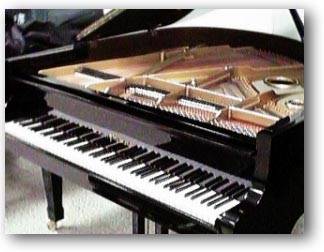|  The Art of tuning.
The Art of tuning.
I like improving constantly my job doing something which can renew and
make it interesting for me once more. Each piano is particular: before
starting the tuning operation you have to calculate (on the base of model
and firm) the possible uccessive resettlement, then vary the way of proceeding,
trying to reach the best result in the shortest time. I tune pianos by
ear, in the traditional way, because it turns out to be the best one:
it fits better to the aesthetic requirements of the ear perception. I
use moreover a small electronic device with a selective microphone to
enhance control possibilities, cutting errors due to external noises and
not perfect acoustic conditions. Tuning is an art: a well tuned piano
has a sweet sound, similar in the high notes, to a carrillon; the majority
of the customers knows the sound of the piano, matched ,in the best case,
with only a light distune but if you listen to a brano executed on a just
tuned piano(hoping it has been made properly), it makes a big difference
because the brano, at last, make a different sense: dissonances vanish,
frequencies coincide, sounds sum, strengthen and become clear and steady,
not approximate or ambiguous. Unfortunately the exact tune vanishes in
few executions and the pianist gets used to the new increasing slight
distune until, day after day it becomes bigger.
|








 The Art of tuning.
The Art of tuning.